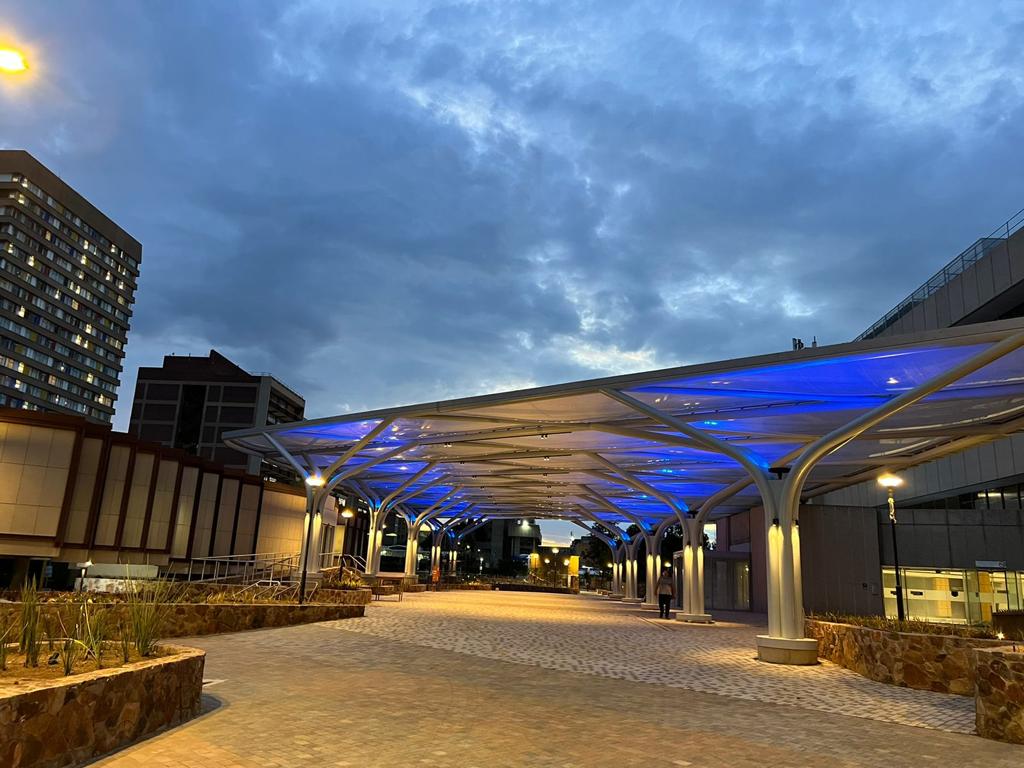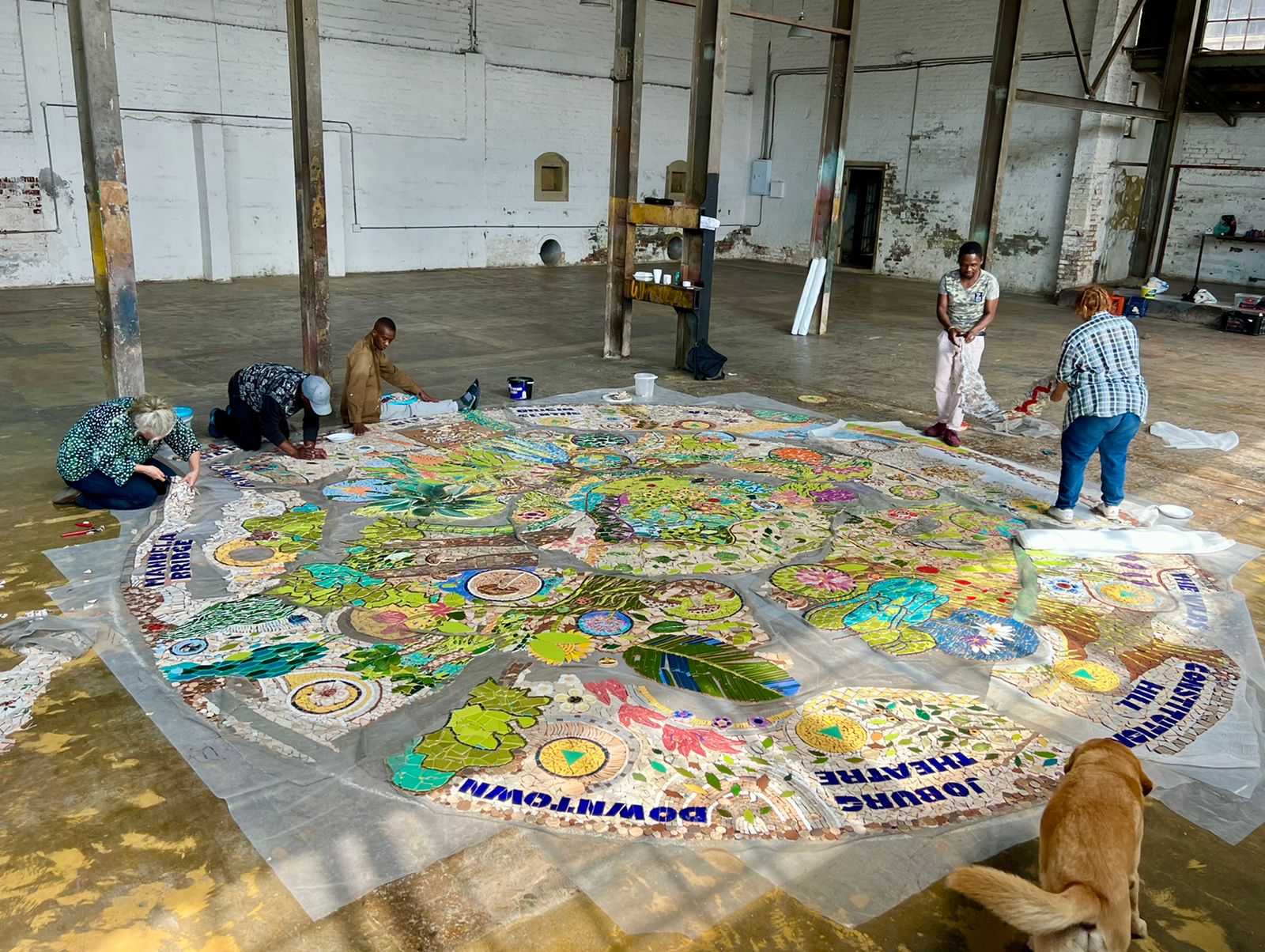STRUCTURE & CULTURE
A new public art sculpture and wellness park soon to launch in Braamfontein
A previously mothballed, cordoned-off area on a historical site in Braamfontein has been transformed into an art, sculpture and wellness park by a team of experts led by architect Edmund Batley.
Opposite Wits University on the Braamfontein Ridge where the legendary SA Breweries building is located, the new park – designed by architect Edmund Batley – is a gateway from the northern suburbs to the city centre, and where Mandela Bridge, the Diamond Building and the Eland sculpture are orientation points. The entrance to the Liberty offices has become a grand porte-cochère and drop-off arrangement.
As yet unnamed, the approximately 4-hectare space promotes visual and physical connection to its urban context while simultaneously providing a space to escape from the craziness of Joburg city life, to reconnect with nature, engage with works of art, take a meditative meander, kick off one’s shoes for a foot massage on a reflexology surface, ground oneself on an earthing mound, or amble through a forest of Highveld trees.
Indigenous trees, plants and grasses, bonsais, medicinal herbs, “lei water” channels with rushing water and tranquil reflective pools all echo the healing spirit of the site.
The concept, which evolved over several years was loosely termed the “Beacon Project”, as in “a beacon of hope” by the team of experts involved.
Beacon Park. Image: James Delaney
Beacon Park by night. Image: James Delaney
Beacon Park by night. Image: James Delaney
Beacon Park Reflexology walk. Image: James Delaney
Beacon Park porte-cochère. Image: James Delaney

Liberty offices Porte-cochère. Image: James Delaney
Beacon Park at sunset. Image: James Delaney
Unlike many others in his profession, Batley does not appear to be bracketed by a particular architectural typology. “We have never built anything that we don’t want to build and we never have any preconceived idea what our projects are going to look like when we start our design process; they evolve from a series of checks and balances of what the final product needs to become,” he says.
He approached professionals who knew the city, understood what would work, and had relevant experience to help him realise the vision of a city park: James Delaney, who reimagined The Wilds; the doyen of indigenous gardening, Patrick Watson; lighting designer Paul Pamboukian; art facilitation company Moja Nation; sustainability consultant and co-founder of PaperThinkLAB, Thulani Kuzwayo; as well as water features expert Pawel Gradowski.
“Every construction or architectural process is massively collaborative” says Batley. “What happened on ‘beacon’ though was highly unusual because Covid contributed significantly to the outcome.”
James Delaney brought important insights from his experience at The Wilds about how to reclaim the carpark and turn it into a place of healing, wellness and reconnection. In fact, “wellness” became the theme for the park.
“Those of us in the design field realised how public spaces are becoming more and more important for people for regeneration and reconnection,” Batley says. “We felt we had to create something that would be accessible to as many people as possible. Will students use it? Yes. Will office workers use it? Yes. Will people from Braamfontein use it? Yes. Will people from the Constitutional Court use it? Hopefully, yes. When those fences come down, it is literally open and everyone can walk in.”

Spaza wellness mosaic; artwork was designed by artist and community activist Andrew Lindsay. Image: Supplied
A vast 6m mosaic compass at the park will be one of the first things visitors see. The artwork was designed by artist and community activist Andrew Lindsay and was completed by his Spaza Gallery team after he suddenly passed away in October 2021.
“It took a while to figure out the scope of the job after Drew died,” Spaza team leader Dionne McDonald explains. “We are working with his original design but I don’t have his colour reference. He always worked in black and white and we worked in the colours as we were going along, but because he is a part of us, he has trained all of us, there is no way that he can’t be present in the work that we do. His voice is in our ears and sometimes I will even say to the crew: Drew is so proud of you for that piece, because I can see that this is something he would like.”
The mosaic captures elements of nature – succulents, a bird’s nest, aloes, fungi, bees, dragonflies, flowering plants, seeds, leaves and flowers, medicinal plants – and also incorporates educational dimensions. Directional markers to sites nearby are incorporated into the design: The Origin Centre, Wits, the Wits Art Museum, The Wilds, the Joburg Theatre, Constitution Hill, Downtown and Newtown.
Speaking about the project, Lindsay had said that working on the design had made him think about how little attention we pay to nature and to where and how we walk. He wanted people to discover elements of the design, like insect images, hidden in the mosaic, adding: “It is also about teaching people to be aware of their environment.”
At least six other artworks by better-known and emerging artists feature in the park – works by Rirhandzu Makhubele, Zanele Montle, Grace Mokalapa, Pat Mautloa, Hannelie Coezee and James Delaney. “Artists have come up with an idea for each location that we designated,” Batley explains.
MojaNation creative visualist Farai Mafurirano says the aim was to enhance a sense of wellness by engaging with the artworks at a spiritual, emotional and intellectual level.
In addition, Kuzwayo explains that a “Net Zero” tool was used to calculate whether developments to the site are positive for ecology. It is not about repairing previous ecological damage but taking steps to improve the site by, for example, planting more indigenous plants and prioritising permeable surfaces over hardscaping.
Kuzwayo’s team surveyed the site and recommended the removal of some alien species as weeds. “The eucalyptus was kept because it is about 60 years old,” he says, adding: “The ecological angle is not limited to plant species and nature. The park is addressing a social dimension that is desperately needed in the city as well as contributing to the idea of rewilding the city or bringing more nature into the city.”
In discussions with Batley and the design team, Kuzwayo promoted a biophilic framework (an approach to design that focuses on improving our “connectivity to the natural environment”). Landscape designer Patrick Watson, who is known for his indigenous gardens, selected plants based on his experience of the 30-acre Hollard Arcadia Campus garden in Parktown, which he designed. He explains: “You let things happen. I always argue with engineers. They say: I will put a column here. I say: I will put a tree here that will seed itself down the hill.”
Together with his son, Jean-Paul Watson, and Abram Mokoti, Watson is doing all the planting while James Delaney selected the medicinal plants. “The concept is grasslands, so it is this surreal thing where you have got wildness in an urban setting. It is spiritual. It is the veld in central Johannesburg and it is about contrast, there are no hedges and things like that… and there are stone walls so you have a sense of country and history, which is quite unusual for the city.”
About 80% of the plants will be indigenous to the Highveld and the rest will be exotic plants from all over the world. “Just to use wild in Braamfontein would be a bit too radical,” he says. The part of the garden that is natural to Braamfontein will bring the butterflies back, and restore it to what it used to be. “It is like bringing artistic wild into an urban setting and I think that is quite nice. They have lots of art and it will work as a sculpture park.” Grasses will include indigenous and ornamental varieties. “I think that will be quite a nice soft spot, especially since it is quite masculine with hard walls and buildings.”
At the back, bordering on Helpmekaar School, the property slopes up to the ridge and down on the other side. “We are exposing rocks that are of geological interest,” says Watson. “They are soldered shales that are part of the Witwatersrand system. The rocks on the Helpmekaar side go to the Indian Ocean and the ones on the other side go to the Atlantic. I think it is exactly on the watershed.”
That’s not all: Yellowwood trees planted in the Breweries garden 60 years ago are still there, and now, more are being added. Wild grasses and 120 stinkwood trees are being planted, and nine additional wild fig trees have been planted in the front of the building.
The original idea was to design a new porte-cochère and to make the historic SAB building accessible to Wits students as part of an entrepreneurs’ ideas initiative. “From Patrick’s indigenous plants to our spine and meandering walkways, to James’s ‘earthing mound’ and stepping stones, to Pawel’s tranquil water features and Paul’s experiential lighting, we have debated things thoroughly. It has been a very, very good team collaboration experience,” Batley says.
“How do you make something relevant to people who live in the city and also attract people who live further away in the suburbs? You have got to make a green space not only beautiful and attractive, but also relevant and engaging so it draws people and makes them come back over and over again,” says Delaney.
He adds: “We have worked with the theme of healing so it will not only be a beautiful landscape to walk through and a nice place to go for a picnic, but there will be much greater depth to the story. Healing is about how plants and landscape can help body and mind too… it is about the smells, the textures and even medicinal qualities of many plants; it’s about meditation spaces, and it is about going to a place where you can relax. These are all aspects of holistic healing.”
Beacon Park Location. Image: Supplied
He believes the park has the potential to attract thousands of people and that its strategic location will also be attractive to tourists. “It is on top of a koppie, a natural lookout point, which is part of the Witwatersrand ridges, which are part of the gold-bearing reef upon which the city is built.”
He also hopes that the Braamfontein park will be a safe space for all to enjoy: “We are taking quite a progressive approach. There won’t be any walls around it, it will stay open till late at night and will be well lit, and there will be security and cameras and visible security, but it is a low-key approach.”
Indeed, evocative, theatrical lighting nuanced for day and night, created by lighting design expert Paul Pamboukian, will be used for sculptures and special features. “The porte-cochère will probably be quite an exciting element that really welcomes one in and sets the scene,” he said.
“Over time, the park will evolve to include bicycle racks, outdoor gym equipment, coffee shops, urban nurseries, food trucks and restaurants,” Batley adds. DM/ ML
The park will be opened later this year.

















 Become an Insider
Become an Insider
This is the most exciting and relevant information Ive heard all year.
A breath of fresh air(!!) indeed.